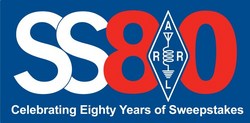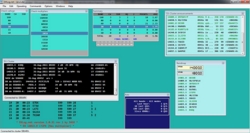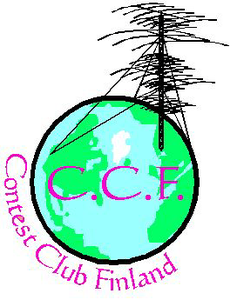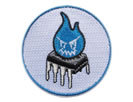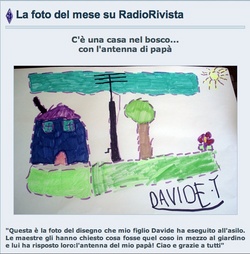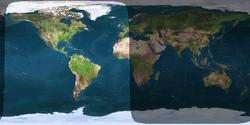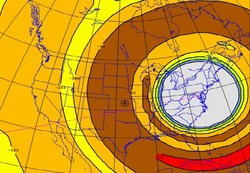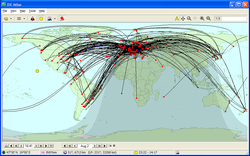 September 25, 2013 Editor: Ward Silver, NØAX | ||||||||||
IN THIS ISSUE
NEW HF OPERATORS - THINGS TO DO If you want to hear how big a state QSO party can be, try the California and Texas contests, with a bit of Maine's QSO party sprinkled in for good measure. All 58 California counties (says N6TV) and all 254 Texas counties (K5IID claims) will be active. Try to work those rare ones - it may be a while before you get another chance! BULLETINS There are no bulletins in this issue BUSTED QSOS Their where know misteaks lassed thyme. CONTEST SUMMARY Complete information for all contests follows the Conversation section September 28-29
October 5-6
Sweepstakes is approaching and this year is special - the 80th running of this oldest of all domestic contests! Now is the time to start planning because there will be a few new corners to "Sweep" this year:
Are you or do you know an operator 80 years old or older? There will be special recognition of our "four-score" operators this year! Watch the Sweepstakes web page for updates, announcements, and more information about this special running of the contest. WRTC-2014 Team Leader applications have been closed after 121 applied to be a Team Leader. 54 Team Leaders will be announced -- 51 who qualified by scoring highest in their Selection Area plus 2 Wild Cards and 1 Youth. Six of the top qualifiers were unable to apply for Team Leader status for various reasons so Selection Manager, Dan Street K1TO says, "...there may be a few surprises ahead!" How come the NA Sprint operators send their call signs in different orders from QSO to QSO? This is always confusing at first to casual participants. Because of the Sprint's QSY rule (the search-and-pounce station gets the frequency after the QSO, basically) it's very helpful for potential callers to be able to tell who is staying around and who will disappear. Thus, the station who will tune away after the QSO begins the exchange with both call signs. The station that will be inheriting the frequency ends the exchange with their call sign. In a contest as fast-paced and short as NA Sprint, this saves a lot of time. (Don't forget to let the receiving station acknowledge they copied everything!)
Dave W9PA writes with news of DXLog, a free contest logging program being developed by Chris 9A5K. "Like Win-Test, DXLog supports the CT command set. In fact DXLog looks and feels a LOT like Win-Test! Some features are identical." A list of currently supported contests can be found on the website. For defining contests, rule sets are defined in plain text files. Along with CW and phone support, DXLog also supports MMTTY for use with RTTY. Exposing the maker-hacker community to ham radio is a good thing, such as the "Guest Rant" column on the Hackaday website for 23 September. Of course, as with most things on the Internet, the comments immediately devolve into obscure squabbles about call signs. Perhaps we could be a little less tribal in our responses to non-hams? While I'm not sure if it's Amateur (Radio Astronomers) or (Amateur Radio) Astronomers, their society is making a call for papers. If your antenna is often pointed overhead, this may be a conference you don't want to miss! Digitize the entire HF spectrum? Sure, why not? Having more data is great but as this EDN article on SDRs explains, "On the other hand, "sometimes enough is too much," a quote variously attributed in different contexts to Mark Twain and Groucho Marx, is equally fitting today, especially in some of the more obscure areas of test and measurement, and especially as it applies to bandwidth." AMSAT-SM has published a comparison of the FUNcube Dongle Pro+ and the RTL TV dongle-based software defined radio. While the FCD Pro+ has a far wider frequency coverage enabling reception of LF, MF and HF, it costs about 10 times more than the RTL TV unit. What other differences are there? You can find out in the AMSAT comparison. The SDRs work with popular SDR programs such as:
Web Site of the Week - The Scandinavian Activity Contest - CQ World Wide issue of Contest Club Finland's PileUP! is ready for you to download. The issue opens with a nice photo of ES5TV's enormous 15 meter H-frame array and other "big boys". (Thanks, Timo OH1NOA) WORD TO THE WISE Why are the traditional amateur HF bands harmonically related? K.B. Warner W1EH answers the question in the December 1924 issue of QST. Page 17 explains, "The Washington Radio Conferences (of the early 1920s), encouraged by the interest of Herbert Hoover, gradually aligned the amateur frequencies to a series of harmonically related bands, so that harmonic interference from the amateur service would fall on other members of the same service ("each service should be charged with the duty of consuming its own harmonic excrescences" Kennelley, pg. 18) or more colloquially "Everybody must eat his own mush." The World Wide Radio Operators Foundation (WWROF) is pleased to present Randy Thompson K5ZD, Director of the CQWW DX Contest for a review of the 2013 contest rules on Sunday, October 6 at 1900 UTC. Questions will be taken from the audience following the presentation. Register now (it's free as always) and use this opportunity to get prepared for the world's biggest DX contest. (Thanks, Ken K4ZW) Jeff K8ND has recorded a short (90 second) video of CW Skimmer operation during the 2009 CQWW 160 CW Contest at PJ2T (#3 that year), as a demonstration of the value of CW Skimmer to the Multi-Op or Single-Op Assisted contester. Viewing in 'Fullscreen' is strongly recommended! The 90-second segment was recorded on January 24 starting at 0514Z, as sunrise was moving across Central Europe. For more on PJ2T's top band capabilities, check out Jeff's planning document.
Randy K5ZD says, "This is the way to work on 80 meter beams. If only you could do this much work in 5 minutes!" He's referring to this video of the SKØUX antenna farm as a crane makes short work of a big project. Have you ever looked wistfully at the light standards in a parking lot and thought, "If I could only climb up there..." Getting an antenna "up there" turned out to be a great application for robotics! David VK2DMH and QRZ.com relayed a website illustrating ham radio in China - the BY hams seem to be a lot like hams everywhere! JC N4IS sends a link to a video of WLW's 1932 500,000-watt AM transmitter posted by K7AGE. Just remember that as loud as it was, the station couldn't hear squat! The August NAQP CW Preliminary Results are now available. If you have any questions, please contact the contest manager, Chris KL9A. Preliminary results from the September CW Sprint are now available, too, says contest manager Tree, N6TR. The Maritime QSO Party results have also been published. Mike VE9AA wishes to thank Bruce VE1NB for compiling all of the scores. The results of the 2013 UBA DX Contest CW have been published on the UBA website. For 2014 there is only one change: Croatia, 9A entered the European Union so 9A will be an extra multiplier and more points for foreign stations. (Thanks, Marc ON7SS/OO9O) Final results of 2013 SP DX Contest are now available, including updated statistics and all-time records. (Thanks, Tom SP7UWL) The results from the Spring EU Sprint contests are now online. Contest managers are looking for a volunteer to create a permanent website for the contest, as well. (Thanks, Dave G4BUO and Dima RW3FO) Bob N6TV checks in to let us know there is a small "Search" box in the upper left corner of the new 3830 score reporting page. You can enter any call sign and quickly find every score that's ever been posted to 3830 going back to 2002, by year, in alphabetical order. "Very impressive work by WA7BNM!" says Bob. OPERATING TIP At the end of the contest, when you've gotten the pre-programmed messages set just the way you want, the windows are all arranged properly, and the configuration settings all "just-so", that is the time to save the program configuration. Many programs store the settings and other information in a single file - look for it in the folder from which your logger runs. For example, N1MM Logger users can save the "N1MM Logger.ini" file. To restore the configuration, copy the saved file into the program directory. No reason not to have several of them! (Thanks, Bob KØRC) DesignSpark PCB is a free printed-circuit board layout software package that now has a mechanical drawing sibling, DesignSpark Mechanical. Learn more about the growing popularity of these two toolsets and the ModelSource online library of electrical and mechanical models in this online EDN article. Scott N7SS notes that, "The new EZ style [RJ-45 network] connectors allow you to strip the network cable long and unevenly and push the wire all the way through the connector. If you use the cool crimper with the proper cutter, it will crimp and flush cut the wires at the same time. If not, you just crimp and flush-cut with a utility knife." Here's a very interesting Q-meter design from EDN that is purely analog - except for the digital voltmeter readout! Elsewhere on the EDN site is a web page that answers the question, "How many different values of resistance can I create using only 1 kohm resistors?"
Mike WØBTU reminds us that there is a good alternative to using a matching coil across a ground-plane vertical's feed point. For his 160 meter inverted-L (155' long with a pair of ¼-wavelength long elevated radials 10 feet off the ground), he matches the feed point impedance with a variable capacitor in series with the coax center conductor to the feed point and a second variable across the feed point from the antenna to the radials and coax shield. This is called an omega match, a type of L-network. Mike's method of building and housing the network is shown in the photo. This interesting article on the Sky & Telescope website suggests issues with current models that predict sunspot cycles. And we all know this cycle has been strange from the git-go. From the article, "David Hathaway (Marshall Space Flight Center), who has done extensive research on the meridional flow and its role in predicting the solar cycle, says the results are "catastrophic" for current theory. "It indicates the need for revolutionary changes in our dynamo models for the sunspot cycle." At any rate, our Sun's current "slacker star" status certainly has confused the scientists. (Thanks, Tom N5EG and Doug KR2Q) Instructables offers a practical way to mount LCD monitors over your operating desk without using a pivoting flex arm. I particularly liked the description of "wandering around a home improvement store" during the design phase of the project - been there, done that! Those pesky local noise sources can drive a ham batty! To help his friends find them, Jim K9YC gave this recent presentation on the subject to the Northern California Contest Club. Jim recommends the Tecsun PL-380 or PL-660 portable HF receivers to track down the noise. As Bob N6TV observes, "Now I know what those strange fuzzy lines on my P3 (K3 panadaptor) represent." The growing amount of e-smog seems to be catching the attention of professionals on both sides of the issue. Veteran broadcast band DXer, Mark WA1ION, offers the following "magic bullets" for good reception when hunting BC DX and that also apply to receiving on the low bands: (a) Select a site with salt water and a clear horizon view towards what you want to hear. Poor ground (rocks, sand, hills/mountains, tall buildings/vegetation) towards side and rear interference directions can help too. (b) Stay away from power lines. (c) Do most listening to the east at sunset before interference from the west builds up. (d) Look at the weather maps to make sure any lightning is a long way off. He has been using a Perseus SDR receiver on his seaside listening sessions and reports that the ability to store spectrum for later playback is an obvious killer-app. His latest car roof receiving antenna might inspire Top Band mobilers and portable operators. Mark notes that on 160, "I would advise a larger size antenna than the 2m by 2m square one I use on the car. You're dealing with smaller signals: sub-100 watt up to 1.5 kW stations instead of multi-kilowatt up to megawatt-plus ones you'd find on the AM broadcast band. Even if you have little interest in broadcast-band DX as a standalone hobby, checking that frequency range does offer propagational clues that can help coordinating 160 meter operation, antenna design, location evaluation, and so on.
Version 2 of AC6LA's EZNEC automation program AutoEZ is now available, including an optimizer, new dialog windows for building common antenna configurations, and it's faster. Note that the program requires Excel with up-to-date service packs installed - no substitutes or older versions will work. Remember the carrier pigeon hauling a thumb drive that transferred data faster than a British telecomm link? Here's an updated story about bandwidth to surprise you! Technical Web Site of the Week - Tom G3OLB refers us to an excellent web site for calculating matching network values. Enter your source and load impedances, enter Q, pick a frequency, and 16 different matching networks are designed on the spot! Note that some network configurations won't be able to match your entered data - those component values will show "NaN", meaning "Not A Number" which is a standard math routine response that means "You've Got To Be Kidding!" The Map Is Not The Territory There are many references to that quote but few include the entire quote by Alfred Korzybski, a Polish scientist from the first half of the 20th century, "Two important characteristics of maps should be noticed. A map is not the territory it represents, but, if correct, it has a similar structure to the territory, which accounts for its usefulness." More succinctly, "Having a map beats not having a map," assuming the map is reasonably accurate. That is true both for those on the ground and those trying to figure out what's happening on the ground, whether spectator or general.
Information - Ham generally and practitioners of radiosport specifically depend greatly on maps. In the simplest case, a map is used in place of a table - of prefixes, abbreviations, zones, continents, etc. By presenting information on a map, the connection between place and data is reinforced and eventually committed to memory. Tactics - The next step is as an operating aid that is used in support of tactics during the event (whether contest or conflict). An azimuthal equidistant map is used to figure out where to point a beam (or not point it as the case may be). A gray-line map showing day and night tiptoeing across the planet helps an operator think about band strategies. And who among us has not colored or placed pins in states or counties or countries or zones in pursuit of an award?
Strategy - Maps are also of great value in devising strategies, particularly in support of antenna selection, installation, and selection. The radiation patterns of an antenna generated by a modeling program are useful, certainly, but they only imply what the antenna will accomplish. The designer has to know other things that affect what is desired of the model - such as probable angles of arrival from the target region, likely sources of interference, the effects of local terrain, variations with time of day and time of year, the state of the solar cycle, and more. Given that radiosport is not a visual "action" activity in the sense of athletics or racing, maps are key to explaining the game. What are we doing? Who are we calling? Why are we pointing our beams in that direction? Where are the other competitors? What was neat about that last contact and why did we ring the bell afterwards, not once but twice? At first, a map explains. When understanding becomes deep enough, the map becomes an integral part of the contest.
Certainly, I've emphasized the geography of radiosport because so much of what we do is related to or depends on where we are located and the geophysical world in which radio exists. A lot of radiosport's structure is predicated on geography. But "map" has a broader meaning - to establish a correspondence between one set of information and another. For example, a scatter chart showing latitude versus score might identify high-performing high-latitude stations otherwise unnoticed among their lower-latitude competitors. A graphic of volume and direction of contacts over time might be a good way to visualize and compare strategies. We have not yet begun to scratch the surface of the visual relationships that are inherent in radiosport. We know them - that's what makes good operators and stations - but we don't know yet how to share them. Once a spectator understands what the game is - knock the ball from here to that hole in the ground over there in the minimum number of attempts - then they can participate. More important to contesters since the quality of the game depends on participation, the spectators might then want to join the fun and play! Why? Because the map helped them understand why this is a neat and challenging activity! Logs and scoring tables and write-ups just won't get the job done. They have to see it to believe it. Next time - what happens when visualization creates abstractions? Can the map become the game? Well, you got to know the territory! 25 September through 8 October An expanded, downloadable version of QST's Contest Corral in PDF format is available. Check the sponsor's Web site for information on operating time restrictions and other instructions. HF CONTESTS SKCC Straight Key Sprint--CW, from Sep 25, 0000Z to Sep 25, 0200Z. Bands (MHz): 1.8-28, 50, Monthly on the 4th Wednesday UTC. Exchange: RST, QTH, name, SKCC nr or power. Logs due: 5 days. Rules CQ WW RTTY Contest--Digital, from Sep 28, 0000Z to Sep 29, 2359Z. Bands (MHz): 3.5-28. Exchange: RST, CQ zone and State/VE area (US/VE). Logs due: Nov 1. Rules Texas QSO Party--Phone,CW,Digital, from Sep 28, 1400Z - See website. Multiple time periods. Bands (MHz): 1.8-28, 50,144, CW--20 to 50 kHz above band edge; Phone--25 kHz above edge of General segment. Exchange: RS(T), county or S/P/C. Logs due: Oct 31. Rules Maine QSO Party--Phone,CW, from Sep 29, 0000Z to Sep 29, 2359Z. Bands (MHz): 1.8-28. Exchange: RS(T), county or "DX". Logs due: Oct 15. Rules NS Weekly Sprint--CW, from Oct 4, 0230Z to Oct 4, 0300Z. Bands (MHz): 1.8-14. Weekly on Thursday evenings local time. Exchange: Serial, name, and S/P/C. Logs due: 2 days. Rules DX/NA YLRL Anniversary Party--Phone,CW,Digital, from Oct 4, 1400Z to Oct 6, 0200Z. Bands (MHz): 1.8-28. Exchange: Serial, RST, and section/province/country. Logs due: 30 days. Rules TARA PSK Rumble--Digital, from Oct 5, 0000Z to Oct 5, 2400Z. Bands (MHz): 1.8-28, 50. Exchange: Name and call area (see website). Logs due: Oct 31. Rules EPC Russia DX Contest--Digital, from Oct 5, 0400Z to Oct 6, 0359Z . Bands (MHz): 1.8-28. Exchange: EPC member nr or serial and grid square. Logs due: Oct 22. Rules Oceania DX Phone Contest--Phone, from Oct 5, 0800Z to Oct 6, 0800Z. Bands (MHz): 1.8-28. Exchange: RS and serial. Logs due: Oct 31. Rules Worked All Britain HF Contest--Phone, from Oct 5, 1200Z to Oct 6, 1200Z. Bands (MHz): 14-28. Exchange: RS, serial, DXCC entity or WAB area. Logs due: Oct 28. Rules California QSO Party--Phone,CW, from Oct 5, 1600Z to Oct 6, 2200Z. Bands (MHz): 1.8-28, 50,144. Exchange: Serial and state/prov/"DX" or CA county. Logs due: Oct 31. Rules EU Autumn Phone Sprint--Phone, from Oct 5, 1600Z to Oct 5, 1959Z. Bands (MHz): 3.5-14. Exchange: Both call signs, serial, name. Logs due: 15 days. Rules RSGB 21/28 MHz Contest--Phone,CW, from Oct 6, 0700Z to Oct 6, 1900Z. Bands (MHz): 21,28. Exchange: Serial and UK district. Logs due: 16 days. Rules OK1WC Memorial Contest--Phone,CW, from Oct 7, 1600Z - See website. Multiple time periods. Bands (MHz): 3.5, 50, 144, First through fourth Monday of each month; see website for bands. Exchange: RS(T) and serial. Logs due: 7 days. Rules ARS Spartan Sprint--CW, from Oct 8, 0200Z to Oct 8, 0400Z. Bands (MHz): 3.5-28. Monthly on the first Monday evening local time. Exchange: RST, S/P/C, and power. Logs due: 2 days. Rules VHF+ CONTESTS ARRL EME Contest--Phone,CW,Digital, from Sep 28, 0000Z to Sep 29, 2359Z. Bands (MHz): 2.3G+. Exchange: Call signs, sig rpt, acknowledgement. Logs due: Jan 1. Rules 222 MHz Fall VHF Sprint--Phone,CW,Digital, from Oct 1, 7 PM to Oct 1, 11 PM. Bands (MHz): 222. Exchange: 4-character grid square. Logs due: 4 weeks. Rules Texas QSO Party--Phone,CW,Digital, from Sep 28, 1400Z - See website. Multiple time periods. Bands (MHz): 1.8-28, 50,144, CW--20 to 50 kHz above band edge; Phone--25 kHz above edge of General segment. Exchange: RS(T), county or S/P/C. Logs due: Oct 31. Rules TARA PSK Rumble--Digital, from Oct 5, 0000Z to Oct 5, 2400Z. Bands (MHz): 1.8-28, 50. Exchange: Name and call area (see website). Logs due: Oct 31. Rules California QSO Party--Phone,CW, from Oct 5, 1600Z to Oct 6, 2200Z. Bands (MHz): 1.8-28, 50,144. Exchange: Serial and state/prov/"DX" or CA county. Logs due: Oct 31. Rules OK1WC Memorial Contest--Phone,CW, from Oct 7, 1600Z - See website. Multiple time periods. Bands (MHz): 3.5, 50, 144, First through fourth Monday of each month; see website for bands. Exchange: RS(T) and serial. Logs due: 7 days. Rules LOG DUE DATES 25 September through 8 October
ARRL Information Click here to advertise in this newsletter, space subject to availability. Your One-Stop Resource for Amateur Radio News and Information ARRL membership includes QST, Amateur Radio's most popular and informative journal, delivered to your mailbox each month. Subscribe to NCJ - the National Contest Journal. Published bimonthly, features articles by top contesters, letters, hints, statistics, scores, NA Sprint and QSO Parties. Subscribe to QEX - A Forum for Communications Experimenters. Published bimonthly, features technical articles, construction projects, columns and other items of interest to radio amateurs and communications professionals. Free of charge to ARRL members: Subscribe to The ARRL Letter (weekly digest of news and information), the ARES E-Letter (monthly public service and emergency communications news), Division and Section news -- and much more! ARRL offers a wide array of products to enhance your enjoyment of Amateur Radio. Visit the site often for new publications, specials and sales. Donate to the fund of your choice -- support programs not funded by member dues! Reprint permission can be obtained by sending email to permission@arrl.org with a description of the material and the reprint publication. ACKNOWLEDGEMENTS ARRL Contest Update wishes to acknowledge information from WA7BNM's Contest Calendar and SM3CER's Contest Calendar. | ||||||||||
